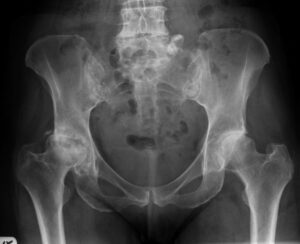
I often hear patients say, “my doctor/therapist says that I have wear and tear of my joints and I just have to accept a slow gradual decline into pain, stiffness and incapacity”. They have been told that it’s an inevitable, all be it regrettable consequence of things wearing out as we age and all that can be done is to replace the joint where possible and put up and shut up where not. It all sounds perfectly reasonable and our everyday experience teaches us that as things age they degenerate and break so we accept it as true and drudge wearily towards our inevitable infirmity.
Yet, what is rarely understood is that healthy joint surfaces either don’t or barely touch one another their design is so intricate and unique and they have near frictionless movement. Also, plenty of people get into their nineties without their joints showing any sign of degeneration at all. Where people do have a degenerative hip for example it is often only on one side and the other joint may be completely normal.
Once you understand clearly that the surfaces of healthy joints don’t even touch one another (which is an exercise in mental gymnastics as is runs so counter to what we’ve been told and our own experience yet can be demonstrated perfectly clearly) then the next obvious question is “why do any of them wear out then?” The answer appears to be that the joint surfaces of degenerative joints are forced together by short, tight muscles.
People sometimes comment that I’m always laughing and joking with my patients, well once you understand this simple truth life as a physiotherapist becomes a lot more simple, enjoyable and easy. The recognition that a lot of the degenerative changes taking place in joints of both the limbs and spine are the consequence of something that the body is doing is incredibly empowering. Put simply, if joint degeneration is something that the body is doing, then the possibility exists that it can stop doing it, particularly with the helpful aid of a skilled physiotherapist stretching and loosening the offending short, tight muscles. Physiotherapy becomes less about patching people up and sending them back out into the world and more about sorting out the cause of their problem and then maintaining the improvements over the long-term.
Even physiotherapists often struggle initially to comprehend that joint degeneration is largely an active and not a passive process. I often give them the example of the arthritic hip as an example. An X-ray of a hip with osteoarthritis will typically show a loss of joint space and flattening of the ball of the joint. It makes sense that the body’s weight could cause these changes, yet an X-ray of an arthritic shoulder shows the exact same changes and in that case the weight of the arm acts to separate the joint and not compress it.
At Sheffield Physiotherapy, we believe that the body has tremendous healing potential and via our expert treatments we can help our patients reap the benefit of their body’s innate ability to heal.
John Wood
Specialist Physiotherapist and Clinical Director of Sheffield Physiotherapy

